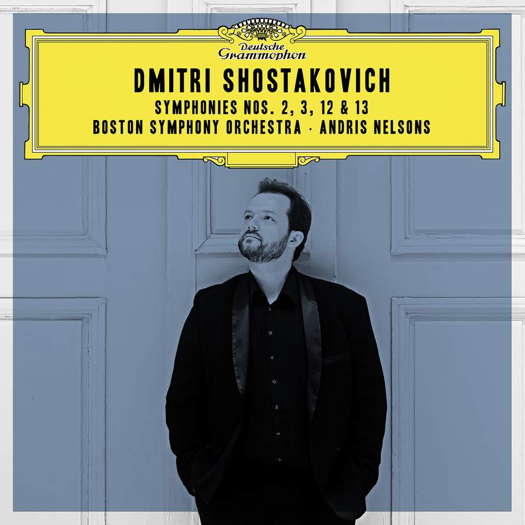 DISCUSSION: What is a work? John Dante Prevedini leads a discussion about The performing artist as co-creator, including contributions from Halida Dinova, Yekaterina Lebedeva, Béla Hartmann, David Arditti and Stephen Francis Vasta.
DISCUSSION: What is a work? John Dante Prevedini leads a discussion about The performing artist as co-creator, including contributions from Halida Dinova, Yekaterina Lebedeva, Béla Hartmann, David Arditti and Stephen Francis Vasta.

Shostakovich at his Sardonic Best
GEOFF PEARCE listens to symphonies by Dmitri Shostakovich connected to the year 1917
'... a very interesting and fine set.'
This very interesting recording showcases three symphonies by Dmitri Shostakovich that revolve around the year 1917 and the events that transpired that momentous year. They are also the three most neglected Shostakovich symphonies. This recording certainly does them justice, and they have found a worthy champion in these assembled forces. The second and third symphonies also incorporate choral forces, and all are to be played as single movement symphonies, although all can be divided into four sections. Also included is Symphony No 13, 'Babi Yar' (although this title was not given by Shostakovich).
The Second Symphony is presented here in two sections. It was composed in 1927, is entitled To October and commemorates the ten year anniversary of the October Revolution. I think this is the strangest of all the Shostakovich symphonies and was very experimental for the time. It is a brief work lasting about ten minutes over all. It is here divided into two sections. The first section starts with one of the strangest openings I have ever heard and simulates chaos from which order emerges.
Listen — Shostakovich: Largo (Symphony No 2)
(4864965 CD1 track 1, 3:11-3:53) ℗ 2023 Deutsche Grammophon GmbH :
This is followed by a rather sadonic yet jaunty march like section, and the music changes quite frequently, is sometimes melancholic, and then almost frenzied dance-like music that is polyphonic. It has to be just about the strangest piece that Shostakovich ever wrote. After a weird fanfare-like moment, the section becomes quieter and reflective and ends quietly.
The second section, as divided on this recording, opens with a siren-like few bars, before the chorus enters with text by Alexander Bezymensky praising Lenin and the October Revolution, and the work ends on an inspirational and celebratory note.
Listen — Shostakovich: My schli, my prossili raboty i chleba (Symphony No 2)
(4864965 CD1 track 2, 0:00-0:51) ℗ 2023 Deutsche Grammophon GmbH :
The Third Symphony is substantially longer and is more in line with the philosophy of the Russian Association of Proletarian Musicians which demands clear and simple expression of musical ideas. The work is entitled The First of May, is the composer's Op 20 and was written in the summer of 1929. Shostakovich, later in life, expressed dissatisfaction with this work, but early performances were positively received, although feelings were mixed among US critics of the time. After the chaos and struggles depicted in the Second Symphony, this one focusses on the joyful working together for peaceful reconstruction. Evidently the plan was not for a formal structure thematically built, but rather a process where themes do not repeat in their entirety, but new material is always being introduced.
The opening section starts with a clarinet solo and is joined by plucked strings, before a second clarinet is added. It is reflective and calm, almost as if an observer is surveying a ruined landscape, not in a despairing fashion, but more in amazement about what had occurred. The pace quickens and the music becomes more resolute and busy, perhaps depicting the frenzy of human activity, but it is generally upbeat and at times syncopated. This is followed by a fugue that uses part of the main theme.
Listen — Shostakovich: Allegretto - Allegro (Symphony No 3)
(4864965 CD1 track 3, 4:06-4:49) ℗ 2023 Deutsche Grammophon GmbH :
The next section begins very quietly, with high strings, then timpani and loud chords in the brass interject, but this does not amount to anything and the quiet strings resume. A faster element is then introduced and various snatches of melody interject, but the effect is not one of chaos, and the whole is held together by the lower strings. There are moments of restraint and great beauty.
Listen — Shostakovich: Andante (Symphony No 3)
(4864965 CD1 track 4, 3:40-4:28) ℗ 2023 Deutsche Grammophon GmbH :
The next section is scherzo-like and whilst at times it is playful and joyful, there are moments of considerable tension as well. The momentum stops about half way through, and the music becomes darker and somewhat ominous with themes and calls in the lower brass and strident trumpet and trombone solos.
The final section sets a text by Semyon Isaakovich Kirsanov praising May Day and the October Revolution. It is not a long movement and is a very effective culmination of this symphony with its exalted chorus.
Listen — Shostakovich: Moderato (Symphony No 3)
(4864965 CD1 track 6, 2:38-3:34) ℗ 2023 Deutsche Grammophon GmbH :
The Twelfth Symphony, Op 112, entitled The Year 1917 as a tribute to Lenin, was composed in 1961 outside of Russia. It has never enjoyed much success, and was often used to illustrate the composer's 'decline' in creative powers, particularly by Western critics. I have always been somewhat saddened by this as it is a work I have enjoyed very much, since I first heard it more than forty years ago. Evidently it was composed quickly. I do firmly believe that this is a much finer work than many give it credit for.
The first movement, 'Revolutionary Petrograd, quotes a revolutionary song Shame on you tyrants and 'The Warsaw march'. It is slow and broad at the beginning, but this theme is then the basis of the Allegro that follows. It is full of fire and excitement, with brass fanfares and woodwind flourishes against the relentless theme in the strings, but later with the full orchestra. This movement is taut and there is a feeling of expectation, even in the brooding quieter sections. This recording makes the most of the contrasts in this movement. I have heard other recordings such as ones by Kondrashin and Rostropovich that are perhaps more exciting and gripping, but this current one is certainly a fine performance. The orchestra responds to every direction by the conductor, but it is slightly less hard-edged than some of the other recordings I have heard.
The second movement, 'Razliv', referencing Lenin's countyside retreat outside Petrograd. Like the first movement, there are quotes from the Eleventh Symphony as well as Shostakovich's Funeral March for the Victims of the Revolution. It is quite mournful with a lengthy trombone solo and a chorale like passage in the horns. There is a restraint from the frenetic activity of the preceding movement. This recording lets the music breathe more than some other recordings I have heard, and this really suits the mood. Of the movements in this symphony in this version, I find this the most effective. The unisons and overall intonation are impeccable and the balance is superb, as are the solos by the various members of the orchestra.
Listen — Shostakovich: Razliv (Symphony No 12)
(4864965 CD2 track 2, 7:14-8:09) ℗ 2023 Deutsche Grammophon GmbH :
The third movement, 'Aurora', is a most effective scherzo and one can sense the cruiser emerging from the mist and firing on the Winter Palace. I have heard more exciting renditions of this movement, and whilst it is admirable, it did not quite match the sense of anticipation and menace of some of those earlier recordings. However, the climax, when the guns are being fired, is impressive.
This movement runs directly into the fourth movement, 'The Dawn Of Humanity', which offers a vision of Soviet life under the leadership of Lenin. It is full of joy and celebration. Earlier themes are referenced, and perhaps there is some questioning, but slowly and surely the celebration takes over, and the future, at least at that time holds great promise reflected in the music.
Listen — Shostakovich: The Dawn of Humanity (Symphony No 12)
(4864965 CD2 track 4, 6:35-7:22) ℗ 2023 Deutsche Grammophon GmbH :
The final symphony on this disc, No 13, Op 113, completed in July 1962 and popularly known as 'Babi Yar', is another of my favourites, since I first heard the 1988 recording with Rostropovich conducting the National Symphony Orchestra and the very fine Bulgarian bass Nicola Ghiuselev. I also enjoy the first recording which was with Kondrashin and the Moscow Philharmonic back in 1962. (That was a live recording and I heard it broadcast a few years later in New Zealand as a boy and was entranced.) The symphony is a long one of about one hour's length and uses five poems of Yevgeny Aleksandrovich Yevtushenko, depicting five moments in Soviet life. It is scored for large orchestra, bass soloist and men's choir. At one point the work, after a few performances, was banned in the Soviet bloc, and a smuggled copy was sent to Eugene Ormandy and The Philadelphia Orchestra who recorded it in 1970. The first and fourth movements, particularly, drew the ire of the authorities of the time.
In the first movement, Shostakovich and the poet renounce anti-semitism in all its forms. The text and symphony had to be revised after the first two performances as the authorities found the text objectionable. It is a movement of between 15-18 minutes in duration and the composer sets the poem (which commemorates the massacre of many thousands of Jews by Nazis at Babi Yar, outside Kiev),reflecting three events - The Dreyfus Affair, the Białystok pogrom and the story of Anne Frank. It is a sombre and reflective work, and whilst there are many changes of mood throughout, the overall mood is one of great sadness. I admit that I had reservations of the choice of Matthias Goerne as baritone soloist. He is a singer I admire a great deal, but I thought that he may have the wrong 'sound' for this work. I was quite wrong, and from beginning to end, he was very impressive, as are the male voice choir. This first movement, I believe, owes quite a lot to Shostakovich's study of Mussorgsky.
The second movement, 'Humour', is Shostakovich at his sardonic best, in which the text and music mock and denounce the endless, and ultimately futile attempts of dictators and institutions trying to destroy any attempts at humour.
Listen — Shostakovich: Humour (Symphony No 13)
(4864965 CD3 track 2, 1:16-2:02) ℗ 2023 Deutsche Grammophon GmbH :
The third movement, 'In the store', depicts the queues of Soviet women, endlessly in line for goods. Shostakovich feels passionately for them and the hardships they endure on a daily basis, and it is a life without much hope or joy, and thus sets the poem as a lament. Apart from a passionate outburst by choir and orchestra towards the end of this movement, it is very subdued.
'Fears', the next movement, was as controversial as the first, and attracted a lot of political condemnation and interference. It deals with suppression under the Soviet government. It is another movement expressing a great range of emotion, from soft and quiet passages to a boisterous and paradoxical march, and violent outbursts. This recording takes a little longer at around fifteen minutes, than many recordings I have heard, but I do not believe the mood and effect of the music suffers because of it. I remember as a boy, I struggled to appreciate this movement, but it has since grown on me, and in many ways, it is the most devastating in its impact.
Listen — Shostakovich: Fears (Symphony No 13)
(4864965 CD3 track 4, 11:18-12:02) ℗ 2023 Deutsche Grammophon GmbH :
The final movement, 'Career', starts with a rather delicious and tender duet for two flutes, and then it broadens out. It is an ironic attack on the self interest and thoughtlessness of mindless bureaucrats. There are a lot of interjections by members of the orchestra, and the male choir also interjects with the baritone soloist. This movement never ceases to amaze me with its inventiveness at every turn, and reminds me why I love this composer so much.
Listen — Shostakovich: Career (Symphony No 13)
(4864965 CD3 track 5, 6:26-7:22) ℗ 2023 Deutsche Grammophon GmbH :
These three CDs are very good indeed. There are moments where I feel the Twelfth Symphony suffers a little in that it could be a little more hard-edged in places, and I think that Symphonies Nos 3 and 13 are the best of this set.
The orchestra performs impressively, as does the chorus, and the soloist Matthias Goerne is very fine. Andris Nelsons is an admirable conductor, who has the overall vision to make this a very interesting and fine set. I do wonder why this selection of symphonies were chosen, as No 13, which is one of my most loved works, was included, because the other three symphonies all relate to the year 1917 and the events of that year, whereas No 13 does not. I was not given the booklet along with the tracks to review, so that is a mystery to me.
Copyright © 26 September 2023
Geoff Pearce,
Sydney, Australia





